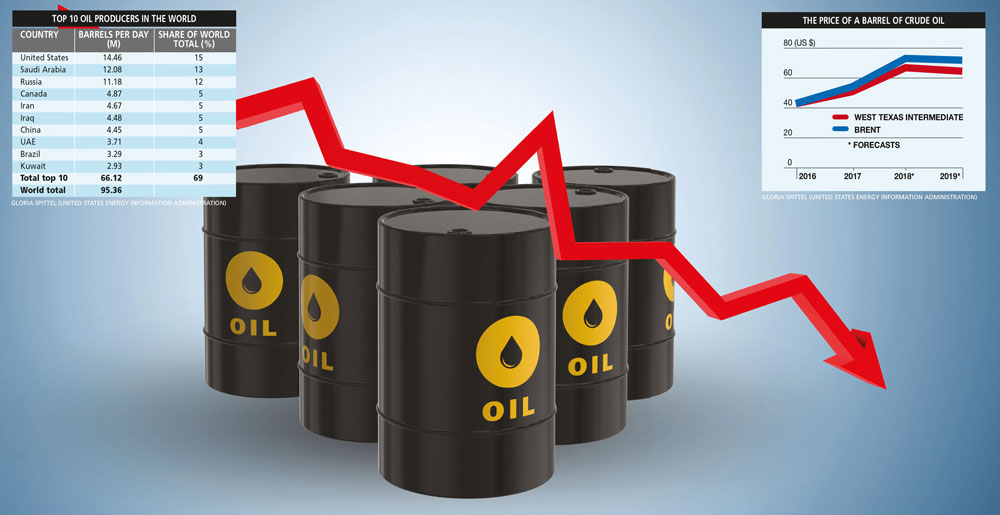THE PETRO INDUSTRY
OIL FUTURES IN THE BALANCE
Gloria Spittel addresses the challenges facing oil producers and opportunities for transformation
Oil’s supremacy crashed years ago. Since the price slump in 2014 and 2015, this vital resource hasn’t reached the golden mark of US$ 100 a barrel, which was routinely met and surpassed, peaking at around 125 dollars between 2009 and 2014 for its mineral lifeline. Furthermore, trajectories indicate that the US$ 100 a barrel level may not be realised for years to come… if ever.
However, for the better part of 2017 and 2018, oil prices stabilised. Buoyed by increased global demand, a reduction in supply through market economics that drove out players – especially providers supplying oil through shale fracking – and geopolitical movements in the Middle East, the price of oil routinely tethered between 70 and 80 dollars a barrel last year.
Yet in November 2018, oil prices fell. The fall in the price of a barrel of oil – although not drastic at the time of writing – was due to a combination of factors. Some of these included US sanctions on Iran targeting oil production and the latter’s refusal to stop production (which contributed to increased supply) and the strengthening US Dollar in 2018, which (similar to its effect on the economies of emerging countries) had an adverse effect on commodities including oil.
Throwing uncertainty into the future of the price of oil and the industry in general is the trade war between the US and China, and the East Asian economy’s growth of 6.5 percent reported in October 2018 for the period July-September 2018. While 6.5 percent is generally considered fast-paced growth by global standards, it represents the slowest in nearly a decade for China!
Yet, the future of the price of oil isn’t too bleak; it merely will not be as lucrative. Given the prevailing environment, the US Energy Information Administration (EIA) expects the average price of a barrel of oil to reach 65 and 72 dollars, for West Texas Intermediate (WTI) crude oil and Brent crude respectively this year.
But low prices and price volatility aren’t the only factors that ail the oil industry. Other variables that will impact the industry include important changes in consumer lifestyles, global economic growth, geopolitical events involving oil producing countries and the continued oversupply of the resource sans political or violent disruptions.
To mitigate the incoming turbulence, industry players – and in some instances, oil producing countries – need to strategise. One way to do this is by employing different forms of technology.
Technology is the buzzword in each and every discussion on maintaining, renewing or introducing competitive advantages in a struggling industry. Untouched for so long, the oil industry faces the same concerns of competition and relevance in a changing world.
To deal with supply driven competition, players will turn to technology – whether it is hardware or software. Beyond the use of digitisation for the better handling and leveraging of data, and use and development of smart or IoT devices in oil fields, there is now talk of using blockchain technology. This would increase the efficiency and security of energy trading.
However, to ensure that technological changes will bring benefits, organisational operations may need to change drastically too. For instance, there could be more collaboration between industry players especially for capital intensive activities.
Regardless of the changes the oil industry introduces and maintains, it will need to reinvent itself in a world where the appetite and demand for oil will decline as consumer lifestyles – driven in part by government policy and direction, and increased self-awareness – evolve to accommodate ‘green living’ to mitigate climate change. Changes in consumer lifestyles do not only equate to the use of electronic vehicles but also a reduction of the use of plastic that requires petrochemicals, which is expected to be the main driver of oil consumption.
According to BP, petrochemicals used in packaging account for approximately three percent of global oil use – and with increasing regulations on the use of plastic, BP has cut its forecast by two million barrels a day.
While the use and demand for oil will not stop immediately (many experts and trajectories suggest that the demand for oil could peak in the mid-2030s or 2040s), the reliance on it will decrease as biofuels and renewable energy sources are harvested more efficiently, and cheaply.
The reliance on and relevance of oil for daily life, and economic growth, will continue for decades to come. But with increasing technological developments in renewable energy, its declining importance is surely on the not too far horizon.
As a result, recognising the approaching changes and drafting strategic plans by industry players is important for its sustainability.
Whether driven by push factors such as consumer trends or government policies and international treaties, oil producers will increasingly look to either develop their own competencies in renewable energy (for instance, BP) or work on innovative ways to utilise oil in the future (for example, to develop more sophisticated carbon products).
So while the oil price slump and volatility are sources of concern for stakeholders, the industry isn’t set to disappear… change on the other hand, is on the offing.







Agree with you!